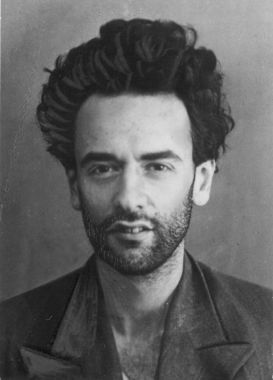Difference between revisions of "Lev Landau" - New World Encyclopedia
(dates) |
m ({{Contracted}}) |
||
| Line 1: | Line 1: | ||
| + | {{Contracted}} | ||
[[Image:Bronstein.jpg|right|thumb|Lev Davidovich Landau in [[NKVD]] prison]] | [[Image:Bronstein.jpg|right|thumb|Lev Davidovich Landau in [[NKVD]] prison]] | ||
Revision as of 20:57, 4 December 2006
Lev Davidovich Landau (Russian language: Ле́в Дави́дович Ланда́у) (January 22, 1908 – April 1, 1968) was a prominent Soviet physicist who made fundamental contributions to many areas of theoretical physics. His accomplishments include the co-discovery of the density matrix method in quantum mechanics, the quantum mechanical theory of diamagnetism, the theory of superfluidity, the theory of second order phase transitions, the Ginzburg-Landau theory of superconductivity, the explanation of Landau damping in plasma physics, the Landau pole in quantum electrodynamics, and the two-component theory of neutrinos. He received the 1962 Nobel Prize in Physics for his work on superfluidity.
Biography
Early years
Landau was born January 22, 1908 into a Jewish family in Baku, Azerbaijan. Recognized very early as a child prodigy in mathematics, Landau was quoted as saying in later life that he scarcely remembered a time when he was not familiar with calculus. At the age of 14 (delayed at his parents' request for a year during which he attended the Baku Economic College), he enrolled at Baku University in 1922, studying in two departments simultaneously: the Physico-mathematical and the Chemical. In 1924 he moved to the Physics Department of Leningrad University, graduating in 1927, and subsequently enrolling for post-graduate study at the Ioffe Physico-Technical Institute/Leningrad Physico-Technical Institute at the young age of 19.
The Landau school
Apart from his theoretical accomplishments, Landau was the principal founder of a great tradition of theoretical physics in the Soviet Union, sometimes referred to as the "Landau school". He was the head of the Theoretical Division at the Institute for Physical Problems from 1937 until 1962 when, as a result of a car accident, he suffered injuries from which he was never fully to recover.[1] His students include Lev Pitaevskii, Alexei Abrikosov, Evgeny Lifshitz, Lev Gorkov, Isaak Khalatnikov and Boris Ioffe.
Landau developed a comprehensive exam called the "Theoretical Minimum" which students were expected to pass before admission to the school. The exam covered all aspects of theoretical physics, and only 43 candidates ever passed.
He also co-authored, with Lifshitz, a popular series of graduate-level physics textbooks that are still widely used.
Great Purge
During the Great Purge Landau was investigated within the UPTI Affair in Kharkov, but he managed to leave for Moscow. Still, he was arrested on April 27, 1938 and released on April 29, 1939 after the intervention of Pyotr Kapitsa.
Notes
- ↑ Dorozynski
Works
Landau and Lifshitz Course of Theoretical Physics
- vol. 1: "Mechanics". L. D. Landau, E. M. Lifshitz
- vol. 2: "The Classical Theory of Fields". L. D. Landau, E. M. Lifshitz
- vol. 3: "Quantum Mechanics: Non-Relativistic Theory". L. D. Landau, E. M. Lifshitz
- vol. 4: "Quantum Electrodynamics". V. B. Berestetskii, E. M. Lifshitz and L. P. Pitaevskii
- vol. 5: "Statistical Physics Pt. 1". L. D. Landau, E. M. Lifshitz
- vol. 6: "Fluid Mechanics". L. D. Landau, E. M. Lifshitz
- vol. 7: "Theory of Elasticity". L. D. Landau, E. M. Lifshitz
- vol. 8: "Electrodynamics of Continuous Media". L. D. Landau, E. M. Lifshitz and L. P. Pitaevskii
- vol. 9: "Statistical Physics Pt. 2". E. M. Lifshitz, L. P. Pitaevskii
- vol. 10: "Physical Kinetics". E. M. Lifshitz, L. P. Pitaevskii
Books about Landau
- Dorozynski, Alexander (1965). The Man They Wouldn't Let Die. (After Landau's 1962 car accident, the physics community around him rallied to attempt to save his life. They managed to prolong his life until 1968.)
- Landau-Drobantseva, Kora: Professor Landau: How We Lived (1999. In original Russian).
- I.M. Khalatnikov (editor): Landau. The physicist and the men. Recollections of L.D. Landau Translated from the Russian by J.B. Sykes. (Pergamon Press, 1989) ISBN 0080363830
- Janouch, Frantisek: Lev D. Landau: His life and work (CERN, 1979) ASIN B0007AUCL0
- Kojevnikov, Alexei B.: Stalin's Great Science: The Times and Adventures of Soviet Physicists, History of Modern Physical Sciences Series. (Imperial College Press, 2004) ISBN 1860944205
See also
- Landau-Hopf theory of turbulence
References and further reading
- John J. O'Connor and Edmund F. Robertson. Lev Landau at the MacTutor archive
- Lev Davidovich Landau
- Landau’s Theoretical Minimum, Landau’s Seminar, ITEP in the Beginning of the 1950’s by Boris L. Ioffe, Concluding talk at the workshop QCD at the Threshold of the Fourth Decade/Ioeffest.
- Modern Landau's Theoretical Minimum
| ||||||||||||||||||||
Credits
New World Encyclopedia writers and editors rewrote and completed the Wikipedia article in accordance with New World Encyclopedia standards. This article abides by terms of the Creative Commons CC-by-sa 3.0 License (CC-by-sa), which may be used and disseminated with proper attribution. Credit is due under the terms of this license that can reference both the New World Encyclopedia contributors and the selfless volunteer contributors of the Wikimedia Foundation. To cite this article click here for a list of acceptable citing formats.The history of earlier contributions by wikipedians is accessible to researchers here:
The history of this article since it was imported to New World Encyclopedia:
Note: Some restrictions may apply to use of individual images which are separately licensed.
